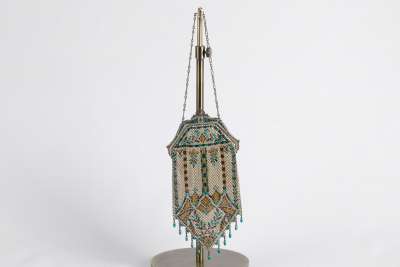The English Singer Sewing Machine Panels are a pair of machine-embroidered artworks, crafted by the Singer Sewing Machine Company for the 1924 Empire Exhibition at Wembley. These panels feature two designs: one depicts a jug of flowers, while the other showcases a classical vase. These designs exemplify the embroidery capabilities of Singer sewing machines during the early 20th century. Originating from England, circa 1924, these pieces highlight the intricate detail and craftsmanship that was achievable with Singer’s innovative sewing technology at the time.
Condition Report
Both panels are in excellent condition, having been carefully preserved over the years. In September 2022, they were placed in conservation framing to ensure their longevity and to protect the embroidered designs from environmental damage. The later conservation framing has been executed with precision, ensuring that the panels are well-preserved for future generations. The panels show no signs of wear or damage, maintaining their original vibrant colours and intricate detailing, providing a testament to the high-quality craftsmanship of the Singer Sewing Machine Company.
Dimensions
Weight: 2.865gm, Length: 38cm, Width: 6.5cm, Height: 52cm. (Per Piece)
A Showcase of Embroidery Skills
These embroidered panels were likely intended as decorative pieces to demonstrate the advanced embroidery capabilities of the Singer sewing machines. During the 1924 Empire Exhibition, these panels would have been used to attract attention and demonstrate the precision and detail that could be achieved with Singer’s machines. They would have served as both an artistic display and a practical example of the machine's capabilities, highlighting the potential for home décor applications and inspiring creativity among exhibition attendees.
Exemplifying Early 20th Century Design
The designs on these panels are emblematic of early 20th-century decorative styles, characterised by their attention to detail and use of floral and classical motifs. The jug of flowers and classical vase designs reflect a blend of traditional and modern influences, common during the period. These motifs were popular in home décor, representing a connection to nature and a sense of elegance. The panels highlight the era's design trends, where machine embroidery began to mimic the intricate details previously achievable only by hand, thus democratizing access to decorative arts.
The Craft of Machine Embroidery
The creation of these panels involved advanced machine embroidery techniques, a testament to the technological advancements of the Singer Sewing Machine Company. The intricate designs were achieved through precise control of the sewing machine, allowing for detailed stitching and complex patterns. The embroidery process would have involved selecting appropriate threads and fabrics to best showcase the machine's capabilities. This level of craftsmanship required not only technical skill but also a deep understanding of design principles, ensuring that each panel was both functional and visually appealing.
Produced by the Singer Sewing Machine Company
The Singer Sewing Machine Company, founded in 1851, became synonymous with innovation in sewing technology. By the time these panels were produced, Singer had established itself as a leader in sewing machine manufacturing. Known for their reliable and durable machines, Singer expanded their offerings to include embroidery capabilities, which were showcased at the 1924 Empire Exhibition. This event was an opportunity for Singer to demonstrate their commitment to technological advancement and the versatility of their products, helping to solidify their reputation as pioneers in the sewing industry.
Collected by Enthusiasts of Historical Embroidery
Antiques like the Singer Sewing Machine Panels are highly sought after by collectors who appreciate the historical significance of machine embroidery and the evolution of textile arts. These panels represent a key moment in the development of sewing technology, making them valuable additions to any collection focused on the history of textiles or industrial design. Collectors are drawn to such pieces not only for their decorative appeal but also for the insight they provide into the technological advancements and cultural trends of the early 20th century, offering a tangible connection to the past.

















